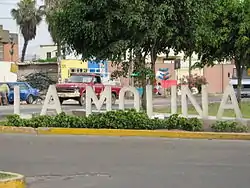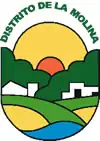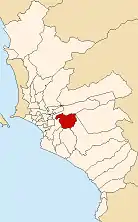La Molina District
La Molina is a district of the Lima Province in Peru, and one of the upscale districts that comprise the province of Lima. Officially established as a district on February 6, 1962, the current mayor (alcalde) of La Molina is Álvaro Paz de la Barra.
La Molina | |
|---|---|
 District sign at La Molina Avenue | |
 Flag  Coat of arms | |
 Location of La Molina in Lima Province | |
| Coordinates: 12°4′40″S 76°54′40″W | |
| Country | |
| Region | Lima |
| Province | Lima |
| Founded | February 6, 1962 |
| Capital | La Molina |
| Government | |
| • Mayor | Álvaro Paz de la Barra (2019-2022) |
| Area | |
| • Total | 65.75 km2 (25.39 sq mi) |
| Elevation | 241 m (791 ft) |
| Population (2017) | |
| • Total | 140,679 |
| • Density | 2,100/km2 (5,500/sq mi) |
| Time zone | UTC-5 (PET) |
| Area code | 12 |
| Postal code | 15026 |
| UBIGEO | 150114 |
| Website | munimolina.gob.pe |
Geography
The district has a total land area of 65.75 km². Its administrative centre is located 241 metres above sea level.
La Molina is located between 12° 00' 07" S, 76° 57' 00" and 76° 51' 00" W.
Boundaries
- North: Ate
- East: Cieneguilla and Pachacamac
- South: Villa María del Triunfo and San Juan de Miraflores
- West: Santiago de Surco
Demographics
According to the 2005 census by the INEI, the district has 124,468 inhabitants, a population density of 1,893 persons/km² and 33,646 households. Annual median income varies greatly.
History
Name
There are two possible origins, both referring to the owners of the estates located in the area in the Peruvian Republican era.
- Captain Nicolás Flores de Molina, owner of La Molina estate.
- Melchor Malo de Molina, Marquis de Monterrico, owner of Monterrico Grande estate.
Creation
In the years before its creation, the estates located in the geographic area of the district (Granados, Melgarejo, La Rinconada, Camacho and La Molina) had been already sold (or expropriated by the Juan Velasco Alvarado administration) and divided, giving origin to smaller yet large properties. Soon, due to the quiet and beautiful surroundings, owning country houses in La Molina became a trend for high class people. This resulted in the populating of the first neighbours, individuals with high incomes. Finally, on February 6, 1962, La Molina district was officially created, and the new district is segregated from the old Ate district, by Act No. 13981 during the Manuel Prado Ugarteche government.
Philanthropy
Some members of the community are active members in "Un techo para mi pais" which helps people in need build houses. TECHO
Districts Structure
La Molina is a residential district, largely high class, in which the urbanizations La Planicie, El Sol de La Molina, Rinconada, La Molina Vieja, Club Campestre Las Lagunas, Camacho, and in upper middle class stand out, such as Santa Patricia and Las Viñas. La Molina is identified as one of the districts where there is no extreme poverty.
La Molina has six large clearly identified sectors:
- Camacho: It is an area located to the west of the district, in which exclusive family houses are located. It is made up of the urbanizations of Camacho; which is very visited by residents of the same district for its striking shopping centers, Santa Sofía Magdalena, the La Fontana urbanization, part of Cerros de Camacho (shared with Groove) and the Monterrico Residential. This area borders the Surco district (Monterrico) and the Ate district (Salamanca). It is crossed by Las Palmeras Avenue, Javier Prado Avenue and Los Frutales Avenue. It makes up 15% of the district.
- La Molina Vieja: It is the southern part of the district. In La Molina Vieja there are exclusive houses that are located in the urbanizations La Molina Vieja, La Alameda de la Molina Vieja, Los Sirius and El Remanso, Corregidor, here you can also find the Faculty of Law and Medicine of the San Martin de Porres University. There are also the Isla del Sol, Las Viñas de La Molina, Portada del Sol, La Capilla (Pro-Housing Association Vemtracom Association), La Molina Valley and Las Lomas de la Molina Vieja urbanizations. Make up 20% of the district.
- Santa Patricia: It is located north of the district, borders the district of Ate (Mayorazgo) and is inhabited mostly by middle-class sectors in high density. It is made up of the quadrant between La Molina Avenue, Melgarejo Avenue, Industrial Separator Avenue and La Universidad Avenue, and includes urbanizations such as Covima and Santa Raquel. It is the largest area of the district. In this one there are centers of higher studies, among them: San Ignacio de Loyola, and Instituto San Ignacio de Loyola. As well as renowned private schools: Jean le Boulch, Antonio Raimondi, Our Lady of Guide, Virgin of the Rosary of Yungay, Bruning, among others. Although it is a residential area, it also develops trade in avenues such as Melgarejo, Los Constructores, Flora Tristán and Javier Prado, especially in regards to restaurants. It is the most visually picturesque urbanization, since important architectural works are found, such as the main headquarters of the Mormon Church (made entirely of white marble) and the main headquarters of the Banco de Crédito del Perú, which is built on a reforested hill.
- The Agrarian University La Molina: it is located in the middle of the district. Due to this university and its large green areas, La Molina is considered an ecological district.
- Rinconada Alta, Rinconada Baja, Rinconada del Lago, La Planicie, El Sol de La Molina, Huertos de La Molina and Club Campestre Las Lagunas. These urbanizations are inhabited by high class people, but the population density is very low. This sector begins in Molicentro and is crossed by La Molina Avenue and Elías Aparicio Avenue. It conforms 20% of the district. Within the Club Campestre Las Lagunas urbanization there are 2 artificial lagoons called Laguna Chica and Laguna Grande. You cannot enter the Laguna Chica because it is surrounded by houses, but you can enter the Laguna Grande. There you can visit it. It also has an island where meetings are held.
- Musa: It is located in the east of the district. It is a "popular" urbanization of middle and lower middle class, it was formed by the workers' association of the La Molina National Agrarian University, SIPA, the Municipality of La Molina and La Arenera. It is located in Squares 46 and 47 of Avenida La Molina or Carretera a Cieneguilla km 10.5, both blocks cross the Jirón Madreselva, whose street belongs to the Musa urbanization, thus ending the district next to the "Municipal Deposit". This urbanization is also accompanied by areas such as "Las Flores de La Molina", "Arbolitos" and "Espalda del Minicomplejo". There is also the CNMx School. 1220 "San José Marello", the "César Vidaurre Reina Farje Municipal Sports Complex", the Musa Cooperative Market, the Depincri La Molina - Cieneguilla and the "Municipal Stadium of La Molina". It is estimated that Musa and its surroundings make up approximately 5% of the district, and it borders the District of Pachacámac (Block 48 De La Av. La Molina / "Paradero Los Sauces" and Arenera La Molina).
La Molina is a district with a profusion of large constructions for the same reason that, several important exclusive Peruvian social clubs have a headquarters in this district, among them:
- La Rinconada Country Club
- La Planicie Country Club
It is the district of Lima with the highest density of green areas, reaching up to 20 m² (square meters) for each inhabitant. In the south of La Molina, on the slopes of the San Pedro, Media Luna and San Francisco hills is the La Molina Ecological Park, which houses 208.6 ha (hectares), and was established on May 12, 2004. Already It has been arborizing with certain species of trees and plants for which sowing campaigns are carried out from time to time. This will be the largest ecological park in Lima. It has more than 13,000 plants between trees and shrubs.
It also houses important private cemeteries, such as La Planicie Cemetery and Jardines de la Paz Cemetery Park.
Urban distribution
La Molina district is divided into middle, middle-high and upper class suburbs.
Upper class suburbs
La Molina is best known for the large and luxurious houses that give shape to expensive properties located in suburbs like La Planicie, Rinconada, Las Lagunas, Camacho, Residential Monterrico, La Molina Vieja, Alameda de la Molina Vieja, Los Sirius, Corregidor, El Remanso and Huertos de La Molina. Numerous Peruvian celebrities, leading business people and political figures live in these suburbs. Due to their relative safety, calm and low population density, these suburbs are highly valued real estate. Furthermore, some of the most exclusive Peruvian social clubs are located in the area: Rinconada Country Club, La Planicie Country Club and Hebraica Club.
Middle and upper middle class suburbs
Santa Felicia, Santa Raquel, Covima, Santa Patricia, La Ensenada, La Capilla, Las Acacias, Los Ingenieros, Pablo Bonner, Pablo Cánepa, La Fontana and Farwest compose the middle and middle-high class area in the district. They compose the largest part of the district. Some suburbs (Santa Patricia, Santa Felicia, Santa Raquel and Covima) used to belong to the neighbouring district of Ate, but they were won over by La Molina. The process was led by the desire of the residents.
Musa is a curious case, because it is a middle class urbanization with a medium population density but it has many sectors of the lower middle class because the construction of its houses was carried out by the relatives of the neighbors since its foundation in the late 1960s However, modern houses with up to three floors are now available, obviously after they have managed to improve the aesthetics of their properties over time. Currently the houses and apartments are more expensive than before, and today, their neighbors are descendants of the founding workers of the urbanization and it has improved a lot, over the years it has thus become a very safe place to live.
Urban development
La Molina faces an accessibility problem because the Javier Prado and Raúl Ferrero avenues serve as the only roads that connect this district with the rest of the city of Lima, and thus become overloaded during peak hours. Modern enterprise buildings, shopping malls and private universities are found in La Molina. An intense urbanizing process has turned La Molina into an example of development and progress for the country.
On Av. Raul Ferrero is located the principal mall of the district, called "Molina Plaza", one of the most important commercial centres of Lima. It was inaugurated in 2005 and belongs to the Brescia Group. This mall helped the commercial evolution of this important avenue where nowadays are found premium restaurants, bars and boutiques.
In education, many of the upper class private schools in Lima are located in La Molina, including Newton College, Colegio Waldorf-Lima, Frankin D. Roosevelt School, Peruvian North American Abraham Lincoln School, Colegio Villa María, Colegio La Recoleta, Colegio Alpamayo, Colegio Antonio Raimondi, Reina de los Ángeles School, Villa Caritas, San Pedro School, Peruvian-German School Reina del Mundo, Colegio Domingo Faustino Sarmiento, Lord Byron School, Colegio Altair, La Molina Christian Schools, etc. Several universities are located in La Molina as well, including Universidad Nacional Agraria La Molina, Universidad San Ignacio de Loyola, Universidad Femenina del Sagrado Corazón (UNIFE) and Universidad de San Martín de Porres.
See also
External links
| Wikimedia Commons has media related to La Molina District. |
- Portal de la Municipalidad de La Molina - La Molina Municipal Council official portal
https://larepublica.pe/politica/1333369-molina-alvaro-paz-barra-virtual-alcalde-boca-urna-ipsos-elecciones-municipales-2018 Catholic Churches - Mass Services
